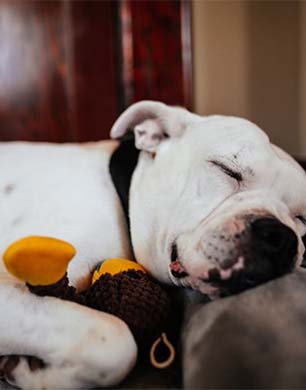 Good sleep is essential for our mood, energy levels and overall health. That said, certain life events can make things difficult. In most cases, we associate sleepless nights with new babies, but if your particular bundle of joy happens to be covered in fur, it can still be a challenge. From choosing the right dog beds to timing meals, it can be difficult to know where to start – so whether you’re dealing with a peppy puppy or an older rescue in need of a little extra TLC, here’s our guide on how to train your dog to sleep through the night including how to find the best beds for dogs and ways to calm your canine before lights-out.
Good sleep is essential for our mood, energy levels and overall health. That said, certain life events can make things difficult. In most cases, we associate sleepless nights with new babies, but if your particular bundle of joy happens to be covered in fur, it can still be a challenge. From choosing the right dog beds to timing meals, it can be difficult to know where to start – so whether you’re dealing with a peppy puppy or an older rescue in need of a little extra TLC, here’s our guide on how to train your dog to sleep through the night including how to find the best beds for dogs and ways to calm your canine before lights-out.
Dogs follow a polyphasic sleep cycle – meaning that they sleep in multiple phases throughout the course of the day (totalling 12-14 hours on average). It can be unhelpful and even upsetting to prevent your dog’s natural instincts – so the goal here isn’t to prevent them from napping during the day, but to make it so they feel more settled at night.
Sniff Out the Culprit
There can be a number of reasons behind your dog’s wakefulness – so be vigilant for signs of illness or injury as well as sleep disorders like sleep apnea. In some cases, you might have nothing to worry about – but if you feel at all unsure, consult your vet.
If your dog is whining or pacing at night, it could be separation anxiety. If they’re a puppy, offer them a dog-friendly plushie scented with their littermates so they’ll feel more at home.
If it’s you they’re pining for, pop an old sweater in their bed – just make sure it doesn’t have fibres they might ingest (these can disrupt your dog’s digestive tract and potentially harm them).
Soothe them to Sleep
Calmly stroke your dog for a few minutes before bed and say “good night” – then repeat when you wake up, saying “good morning”. While this might seem unusual, dogs can understand a surprising amount – and a gentle pet can help to reassure them.
Train for Success
Training isn’t just about learning tricks – it can also provide your dog the mental and physical stimuation they need to feel tuckered out enough that they don’t disturb you in the night. Training can also help your dog to get in the routine of sleeping in their own bed.
To do this you can use clicker training. Say a simple command such as “in your bed” – placing a treat on their bed. Then (once they’re on the bed) treat them again, using the clicker to help them make a positive association.
Be Patient
If they’re finding it difficult, to begin you can gently guide them towards the bed. In time, phase out both clicker and treat so that your dog will associate the command with the action. This can take time and a lot of patience (despite the old saying, you can teach old dogs new tricks – it just requires a little more time).
While it might go without saying, the best way to get a dog to respond well is to reward positives and ignore (rather than punish) unwanted behaviour. Raised voices and rolled newspapers are unhelpful and could even make your dog wary of you – so even when things are frustrating, be kind.
Get in the Habit
Dogs require stability and a sense of routine – so establish this right from the start with a regular daily schedule. Not only will this help them to feel more secure, it can also allow them to identify certain times of day with rest and sleep. You can start by getting the basics down: sleep, diet and exercise.
Find their Happy Place
While there are pros and cons to co-sleeping with your pet, never do this with a small puppy or toy breed (they could potentially suffocate if you roll over in the night). Instead, it’s a good idea to look at the range of dog beds available to determine which one suits your dog’s needs. Beds for dogs come in various styles, such as orthopaedic beds for older dogs. If you’re unsure, consult your retailer who can advise on size, shape and materials such as chew-proof fabric.

